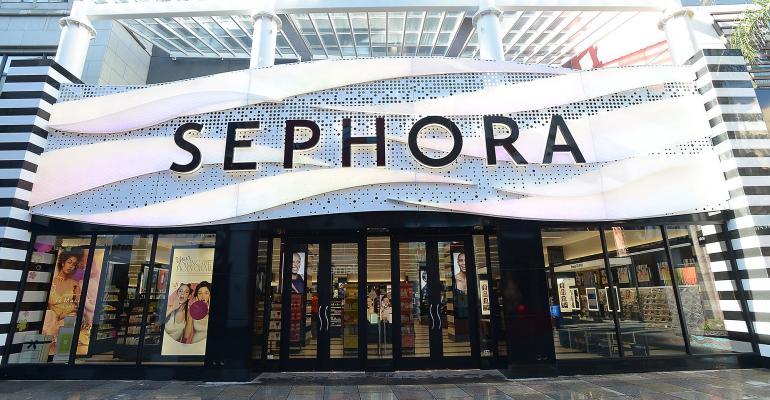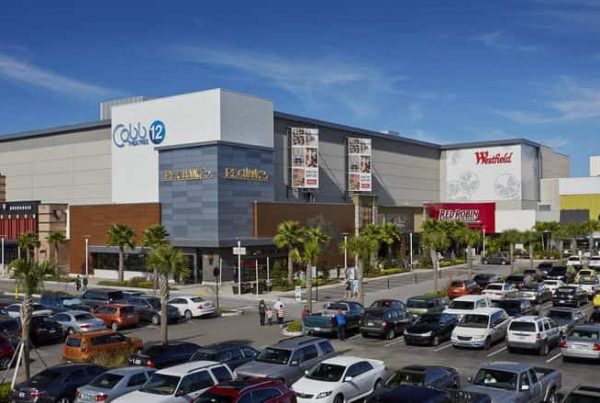Liz Wolf March 21, 2019
Beauty industry giants Sephora and Ulta continue to thrive and expand as other specialty chains struggle.
Struggling retailers may soon be asking beauty industry giants Sephora and Ulta Beauty what their secret is, as both are expanding their bricks-and-mortar footprints at a time when many retailers are retrenching.
Beauty is one of the few retail categories that’s growing in the tumultuous retail environment, and that’s good news for retail center owners.
“Landlords love this sector because it’s a traffic driver, has strong fundamentals and doesn’t show any signs of slowing down soon,” says Rachel Elias Wein, president of WeinPlus, a St. Petersburg, Fla.-based enterprise strategy consultant for retailers and real estate owners. “It services not only the existing need that used to be serviced by department stores, but also the new and growing opportunity that social media has created for beauty.”
Social media is quickly changing how beauty brands connect and communicate with shoppers, especially millennial and Gen Z shoppers. Beauty brands have many of the most-followed accounts on Instagram. In fact, 96 percent of beauty brands are using the platform.
And beauty is a massive industry. In 2018, the U.S. market for beauty and personal care products reached about $90 billion.
How consumers shop for beauty products changed
While department stores used to be the place where consumers shopped for luxury make-up products, specialized cosmetics retailers Ulta and Sephora have transformed the beauty scene.
“Sephora and Ulta are growing into a market that’s hungry for beauty, service and experience,” Elias Wein says.
“When you chart the rise of these beauty retailers, it mirrors the decline in the department stores,” she notes. “It used to be that high-end cosmetics had to be purchased at those department stores, and with the advent of these beauty retailers, you no longer needed to go into a department store for cosmetics and beauty products. Sephora and Ulta didn’t kill department stores, but they may have accelerated their decline.”
Although cosmetics can be purchased online, a key reason that Sephora and Ulta continue to thrive is that consumers want to visit stores to try out new products and get expert advice. These retailers give shoppers a reason to go into their stores.
Industry experts say Ulta and Sephora represent experiential retail at its best. They allow consumers to sample make-up and skincare products and offer customized services. Both chains have strong loyalty programs and also provide a seamless omni-channel experience to keep up with consumers’ demands.
“They’re successful by tapping into our need for elevated service and differentiation,” Elias Wein says. “There are certain things the internet is great at, but if you want to experience color and texture, that’s harder on a mobile device or desktop.”
What about e-commerce competition?
Amazon is increasingly making headway in the health, wellness and beauty categories. In fact, it just launched an exclusive line of beauty products by Fast Beauty Company.
The giant e-commerce player offers more than 200,000 beauty and personal-care listings on Amazon.com, with make-up being the largest category, accounting for 33 percent of beauty products, reportd global market research firm Coresight Research.
However, most Amazon beauty customers gravitate toward lower price points, according to research and advisory company Gartner. Eighty percent of Amazon’s best-selling skincare and cosmetics products cost less than $20 vs. just 8 percent of Sephora’s top products and 20 percent of Ulta’s.
A glowing sector
“The beauty sector is very healthy right now,” says Michael Brown, a partner in the retail practice at global consulting firm A.T. Kearney. He points to three primary reasons for this: innovation, creating experiential stores and benefitting from the shift of traffic from department stores to open-air centers and stand-alone beauty retailers.
Brown also points to two types of beauty product transactions. One is replenishment, where a consumer reorders a product they’ve previously purchased. “That’s leveraged online and both Seporah and Ulta have efficient capabilities and great websites to be able to do that,” he says.
The other is the trial of new products. “That’s where the consumer wants to work with somebody in the store,” Brown notes. “They want to see what a product is going to look like on them. They want to explore those vibrant colors in person.”
When it comes to innovation of products and consultation, the “store is a great environment for beauty,” Brown says.
Amidst closings, select retailers expand
So far this year, Coresight reports 5,279 announced store closures and 2,395 announced store openings, including Ulta and Sephora locations.
“Ulta is typically looking for 10,000-square-foot locations in power and regional centers, where Sephora is looking for urban and mall locations with a smaller footprint,” Elias Wein says.
She adds that Sephora tends to stock mid- to higher-priced items plus its house brand merchandise, whereas Ulta has a broader range of products, including traditional drugstore brands and up to high-end make-up and skincare. Ulta stores also frequently include a full salon.
Sephora expands
Sephora, which operates more than 1,100 locations—both freestanding and inside J.C. Penney stores – announced it will open 35 new U.S. locations in 2019.
Sephora executives say this marks “five years of significant brick-and-mortar growth for the omni-retailer,” which is owned by LVMH.
The chain’s expansion began on March 14 with the opening of a store at New York City’s Hudson Yards development; other locations will include Palm Springs, Calif.; Charlotte, N.C.; and Los Angeles.
Each store will offer 13,300 products from more than 200 brands and digital tools like “Fragrance IQ,” which allows shoppers to identify which scents best suit their preferences. Stores also offer complimentary beauty sessions.
“Sephora is held out as one of [the] best omni-channel experiences, leveraging their in-store technology, as well as their website, to really engage the consumer in the trial of products, and in terms of using social media to help the consumer in the store communicate those experiences,” Brown says.
Sephora also announced it’s partnering with OrangeTwist, which offers non-invasive body, face and skin treatments, at three California locations.
Although LVHM doesn’t break out Sephora sales, it reported that “Sephora had another year of growth and market share gains.”
Ulta announces significant growth, new stores
Last week, Ulta reported its fourth-quarter 2018 financial results, and the massive beauty retail chain beat analysts’ projections following a boost in store traffic and online sales. Ulta currently operates 1,174 stores.
The chain announced plans to open 80 new stores in fiscal 2019, take on approximately 20 remodel or relocation projects, and complete approximately 270 store “refreshes.”
Ulta’s same-store sales jumped 9.4 percent in the fourth quarter, outpacing expectations of 7.9 percent growth. Online comparable sales increased 25.1 percent. Net sales increased 9.7 percent to $2.12 million—topping estimates of $2.11 billion.
Since the earnings report, Ulta stock is rising to all-time highs. At its closing on Tuesday (March 19), Ulta was trading at $334.14 per share. Previously, the highest price Ulta shares traded at was $322.19.
Late last year, Ulta partnered with billionaire reality star Kylie Jenner to exclusively bring Kylie Cosmetics to its brick-and-mortar stores. The move is drawing both investors and shoppers to Ulta.
Cowen and Co. analyst Oliver Chen wrote in a recent note to clients that “newnesss accounted for 40 percent of comp growth in fourth quarter” for Ulta with the launches of Kylie Cosmetics and the Morphe brand.
“Cowen views Ulta’s ability to continuously find key brands like Kylie and Morphe as an important way to broaden its customer file moving forward, as both brands brought new, primarily younger, shoppers into Ulta stores,” Chen wrote.
He also said Ulta’s “unique shopping format is a differentiated crowd pleaser that keeps loyal customers coming back.” Key drivers include the store’s combination of top prestige and mass brands in an easily accessed 10,000- sq.-ft., off-mall specialty store environment with friendly and accessible customer service, plus a salon.
Other beauty retail concepts expand
Macy’s Inc. acquired Bluemercury, a luxury cosmetics brand, in 2015 for $210 million. Macy’s is
expanding the concept by opening new stand-alone stores and continuing the rollout of Bluemercury shops-within-shops within Macy’s stores.
Online beauty brand newcomers Birchbox and Glossier have broken into the bricks-and-mortar market. Glossier now operates a New York flagship store in SoHo and permanent locations in Los Angeles and Chicago.
“With incredible growth and eyes on an IPO, Glossier is taking their time with physical locations, opening up carefully and making those stores an experience that can’t be had on the internet,” Elias Wein says.
Also, Birchbox has partnered with Walgreens for shop-in-shops within select Walgreens stores.
However, not all bricks-and-mortar beauty chains are experiencing the same level of success. By the end of March, the affordable beauty brand E.L.F. Cosmetics will leave the bricks-and-mortar business by closing all 22 stores to concentrate on expanding its online sales and selling its products at national retailers like Walmart, Ulta and Target.








